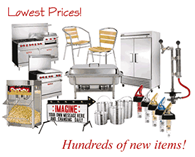Before you buy an over for your restuarant there are some things you must carefully consider. First, what kind of food does your restaurant serve? The style of oven that your restaurant requires depends on the type of cooking you will do. There are four primary types of ovens: convection ovens, conveyor ovens, cook and hold ovens, and pizza ovens (Other things to consider).
Convection Oven
Convection ovens are much like standard ovens except that they are equipped with a fan that helps circulate the air inside. As a result, heat flows more evenly throughout the oven, resulting in faster cooking times and more uniformly cooked food.
Convection ovens can run on electricity (110, 280, or 240 volts), natural gas, or propane gas. They are typically designed with coved corners for easier cleaning and come equipped with a one-year warranty.
Expect to pay up to $2,000 for a half-sized oven, $3,000 to $5,000 for a single-deck style, and about twice that amount for a double-deck version.
Conveyer Oven
Conveyor ovens offer the advantage of consistency with its design. Once you set the cooking temperature and conveyor speed, you just need to place the food at the opening of the oven and wait for it to come out on the other end of the tunnel. If you have ever been to a Quizno's, you will see that they use smaller conveyer ovens to toast the subs.
Conveyor ovens can be used to cook a wide range of foods including pizza, sandwiches, meats, pastries, and breads. Given the oven's enclosed design, it's important to check how easy it is to clean the oven since there are so many internal parts.
You will find conveyor ovens in countertop and freestanding designs. Conveyor widths vary from 14 to 32 inches and feature tunnel lengths from 18 to 70 inches. Some designs can be stacked on top of another oven to save on space.
Conveyor ovens are generally more expensive than other designs. Expect to pay $4,000 to $10,000 for a small countertop unit. Prices for double- and triple-decker versions are easily twice that amount. Standalone conveyor ovens cost $30,000 to $65,000 and more.
Cook and Hold Oven
Much as its name suggests, cook and hold ovens allow you to cook food and keep it warm without having it dry out for a period of time - up to 24 hours.
These ovens are designed to cook food and then be programmed to shift cooking to a "hold" mode when the cooking is complete. This "hold" cycle can get triggered when a certain internal temperature is reached for meats or when a certain cook cycle is achieved.
Cook and hold ovens range from small countertop to large floor models, and vary in price from a few thousand dollars up to ten thousand dollars based on its capacity.
Pizza Oven
There are a variety of pizza ovens available, but the most typical style found in pizzerias is the pizza deck oven. This type of oven features a single compartment that allows you to slide one or more pizzas into the oven for simultaneous cooking.
Standard pizza deck ovens are about 3' wide, 2' deep and 7" tall. Large capacity ovens are about 50 percent larger on all dimensions. They are generally available in single-, double-, or triple-stack configurations.
While countertop versions of deck ovens can be found for a couple of thousand dollars, expect to pay $5,000 to $12,000 and more for the more robust standalone versions.
Other Questions To Consider
- How much space do I have for the oven?
- How easy it to clean the interior, especially the corners?
- What is the range in temperature I need?
- How many racks can be held in the oven?
- How many rack positions are there?
- What are my warranty options?
- What are the power requirements?
- Are there any special venting considerations?


No comments:
Post a Comment